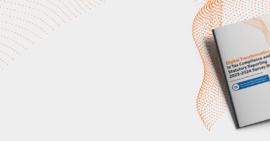As part of the transition to an all-digital economy, tax authorities around the world are implementing various forms of e-invoicing and/or continuous transaction controls (CTCs) to gain more control over—and insight into—business transactions, both within their borders and cross-border.
In this three-part series, we will explain what e-invoicing/CTC is, how it works, why it is gaining popularity, what technology and compliance challenges e-invoicing presents to corporate tax, finance, and IT teams, and share some best practices for doing business in an e-invoicing/CTC regime.
Part 1 of the series will cover the e-invoicing basics that every company needs to know; Part 2 will look in-depth at the compliance challenges of switching to e-invoicing, as well as highlighting the importance of consolidating e-invoicing vendors, and Part 3 will explore some of the regional complexities that companies may encounter, as well as updates on regulatory changes and strategies for keeping up with the reporting requirements that typically accompany e-invoicing/continuous transaction controls (CTC) mandates.
Throughout the series, Nazar Paradivskyy, VP of Regulatory Affairs at Pagero, will provide insights on what companies need to know for a seamless transition into this new era of real-time digital tax controls, illustrating how Thomson Reuters ONESOURCE platform connects financial systems directly to Pagero’s smart business network to facilitate compliant e-invoicing globally.
What is the difference between e-invoicing and continuous transaction controls (CTCs)?
E-invoicing is a digitized form of traditional manual invoicing. Instead of using paper, companies send and receive invoices in a digital format such as PDF, XML or use specialized electronic invoicing platforms that automate the issuance, exchange, and payment of invoices. It does not necessarily involve real-time connection to tax authorities.
Continuous transactional controls (CTCs) require businesses to provide transaction data as well, in near or real-time to infrastructures defined by tax authorities. So instead of reporting aggregated or summarized data long after the event (so-called, post-audit), as in VAT return or VAT listing, companies must be capable of electronically generating and exchanging data in a way that can both automate invoice processing and tax reporting. Manual methods simply cannot keep up, especially in CTC jurisdictions.
Due to its digital nature, and the growing demand for transparency in business transactions by governments, e-invoicing poses several technical and regulatory hurdles for companies. These challenges include the lack of widespread global standards concerning mandatory data elements, formatting guidelines, and methods of exchanging data.
However, as many countries are free to develop their own rules and technical requirements, this means that companies must understand and comply with each individual country’s rules, regulations, frequency, and data specifications. To meet these requirements, companies often need to upgrade their systems, develop new processes and workflows, acquire new professional skills, and facilitate more communication and information-sharing between key departments.
Why e-invoicing? Why now?
One of the reasons tax authorities are gravitating towards e-invoicing / CTC, is that it gives governments a clearer picture of the tax revenue—particularly — they can expect from the business activity. According to Pagero’s Nazar Paradivskyy, there are several other reasons why e-invoicing is so appealing to governments.
“As businesses go digital, so do tax administrations,” says Paradivskyy. “Governments realize the power of collecting and analyzing data in real-time, especially to prevent irregularities such as tax fraud or evasion. But that’s not the only reason for the change. Governments also realize that faster, more granular data can bring greater value to society.” During the COVID pandemic, for instance, governments that had real-time data could be more surgical about supporting businesses and industries that needed help”, Paradivskyy explains.
How companies benefit from e-invoicing?
Governments aren’t the only entities that benefit from e-invoicing; companies can benefit as well. Besides the fact that manual invoicing is time-consuming and can be prone to errors, there is typically a lag time between the time an invoice is properly generated (meaning, fulfilling regulatory and business requirements) and sent to a customer, and the speed at which businesses receive payment. Automated e-invoicing improves cash flow by eliminating the manual exchange of invoices with customers. Consequently, companies that use e-invoicing save time, experience fewer errors and have better control over their cash flow. Finally, non-electronic invoicing is much more costly to businesses, if handling costs are taken into account, compared to true e-invoicing.
What is the process for setting up e-invoicing?
Though e-invoicing ultimately saves time and money, setting it up might involve a significant amount of cost, regulatory and technical know-how, and ongoing maintenance. How significant such investment will be depends, however, on how businesses decide to implement it. Some practices are better than others.
Multinational corporations (MNCs) must incorporate e-invoicing software/services into their existing ERP and financial systems, connecting them not only with their trading partners, but as well to government infrastructures. However, the real challenge is making sure the system is being fed the data it needs, and that the proper data codes are being generated in the correct format for each country and trading partner ecosystem in which the company operates. This may involve some restructuring of workflows and processes, as well as more active communication and data transparency between departments. Rules and regulations are constantly changing as well, so the software one chooses should include automatic updates, that are deployed in the least intrusive way for your operations.
The challenges of compliance
In the next blog, we will explore the challenges posed by CTC e-invoicing mandates in over 80 countries whereby companies have historically employed various systems to address these evolving requirements, often using disconnected systems or services for different regions. With the emergence of new e-invoicing mandates, there’s a growing demand for a unifed solution that not only caters to current needs but also allows for streamlined operations across all countries, eliminating the need for separate, independent solutions.
“Businesses should assume that CTC e-invoicing mandates are here to stay,” says Paradivskyy. “Being reactive will be costly, so companies should be reviewing their existing systems and processes, and partnering with a reliable network vendor to support them in this transformational journey.”


